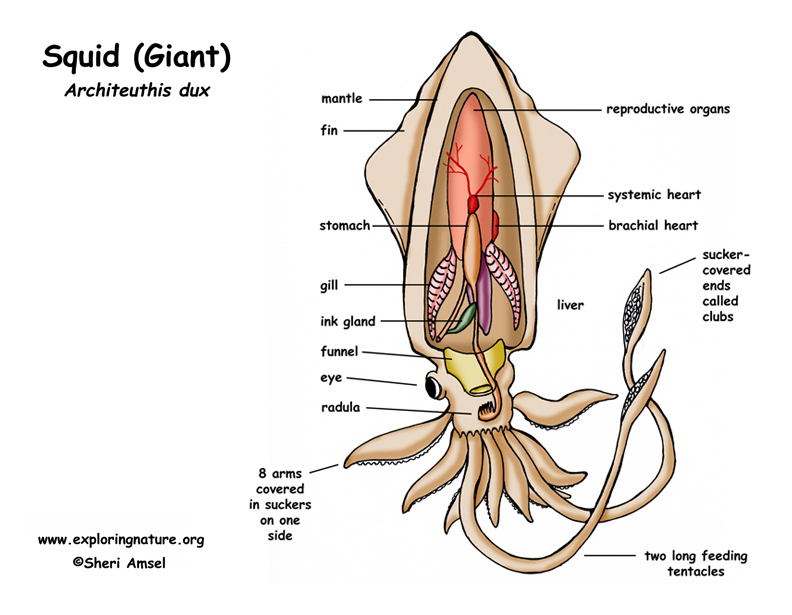

They are found throughout all the oceans.
They are thought to live in the deep, water habitats along the continental shelf and offshore islands, preferring cold, temperate oceans though not polar waters. They are rarely found in tropical ocean habitats.
The giant squid holds many size records. They are not only the biggest squid, but are the biggest animal in their phylum – mollusca. They are also thought to be the largest invertebrate in the ocean, reaching up to 60-feet long (18 m) and weighing up to a ton (2,000 pounds – 900k). Females are larger than males.
They have a body with fins, a head, a sharp beak, 8 arms covered in suckers on one side, and the two long feeding tentacles. The tentacles are much longer than the rest of the body reaching up to 40 feet long (12m), the tips covered in suckers. These sucker-covered ends are called their “clubs.” They have large eyes, each the size of a dinner plate (again the largest on Earth) and excellent vision. They also have a brain and are thought to be intelligent. They have gills for breathing and an ink sac for spraying dark-colored ink when escaping predators. They use their muscular mantle to shoot water out through the funnel for a quick escape.
Very little is known about their habits, because it is very difficult to view a live giant squid.
They eat fish and other squid, grabbing them with the suction clubs on the end of the tentacles and pulling them into their legs. Once gripped in their legs, they can stab them with their sharp beaks before stuffing them into their mouth. Prey is further broken down by the radula, the rasping structure lined with sharp, little teeth. Once the food is shredded, their muscular tongue helps direct it down the digestive tract.
Only the sperm whale has been found to have giant squid in its digestive tract on a regular basis.
Females are thought to be able to produce a million tiny eggs. As with all invertebrates, most of these hatching young are probably eaten by predators. The surviving young grow quickly, probably reaching adult sizes in less than 2 years. Rapid growth helps them outgrow any potential predators, who might eat them.
Unknown
Kingdom: Animalia
Phylum: Mollusca
Class: Cephalopoda
Order: Teuthida
Suborder: Oegopsina
Family: Architeuthidae
Genus: Architeuthis
Species: Architeuthis dux
When you research information you must cite the reference. Citing for websites is different from citing from books, magazines and periodicals. The style of citing shown here is from the MLA Style Citations (Modern Language Association).
When citing a WEBSITE the general format is as follows.
Author Last Name, First Name(s). "Title: Subtitle of Part of Web Page, if appropriate." Title: Subtitle: Section of Page if appropriate. Sponsoring/Publishing Agency, If Given. Additional significant descriptive information. Date of Electronic Publication or other Date, such as Last Updated. Day Month Year of access < URL >.
Amsel, Sheri. "Squid (Giant)" Exploring Nature Educational Resource ©2005-2024. December 14, 2024
< http://exploringnature.org/db/view/570 >

